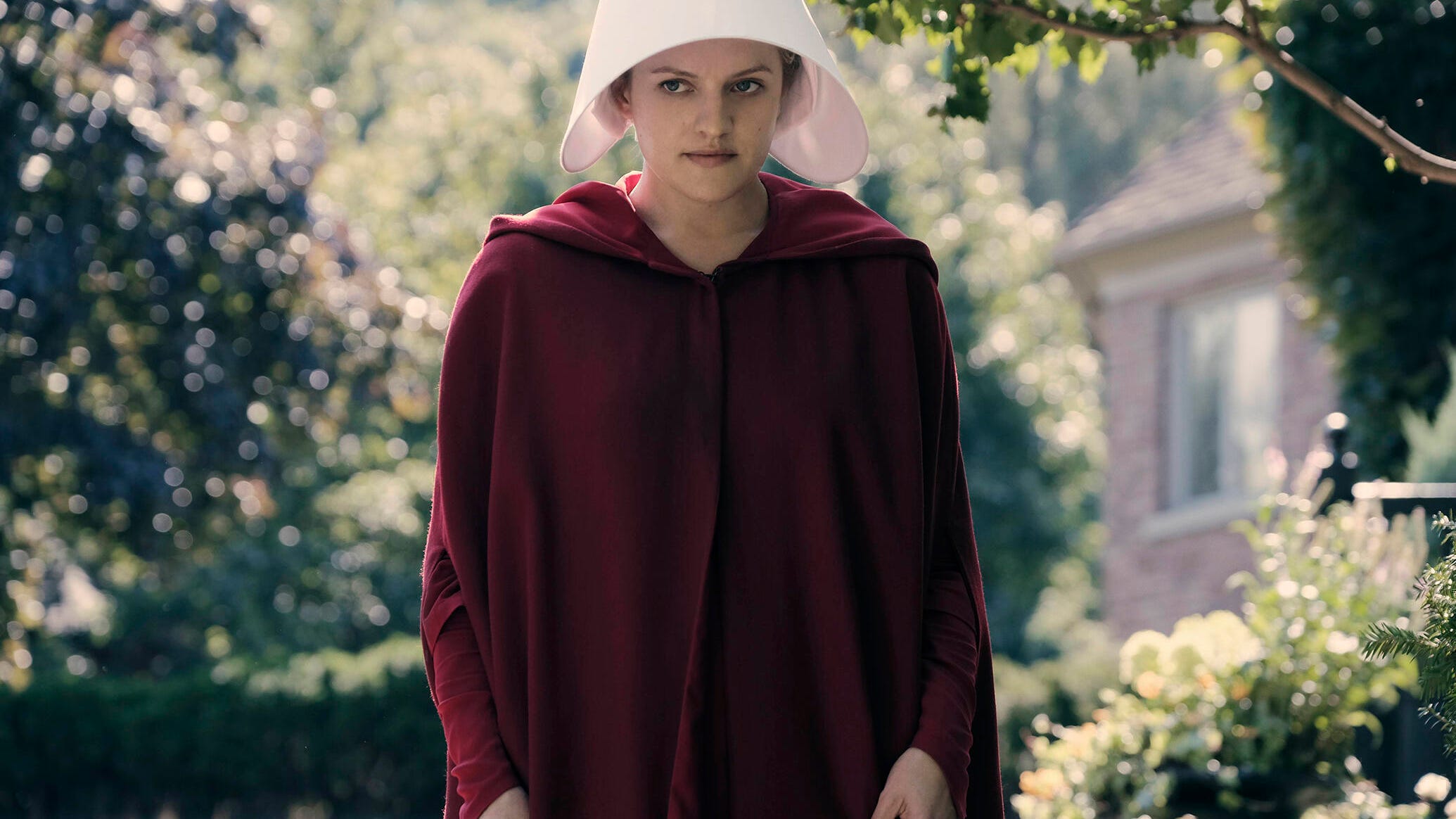
Best Dressed: How 'The Handmaid's Tale' Created the Most Iconic Look of 2017
Don't let the costumes grind you down.
Music, it seems, is costume designer Ane Crabtree's muse.
The Emmy-nominated designer ofThe Handmaid's Tale credits a mash-up of Blondie's "Heart of Glass" and Philip Glass' "Violin Concerto" as being instrumental in designing the show's unforgettable, blood-red dress and cloak.
The show's star, Emmy winner Elisabeth Moss, sent a copy of the remix to Crabtree prior to her first fitting as Offred, the protagonist of the dystopian Hulu series. The "Heart of Glass (Crabtree Remix)" -- so named because the DJ who created it is serendipitously also named Crabtree -- became an unofficial anthem of sorts.
Crabtree says she played the song, which was eventually used to harrowing effect in the series, over and over during that very first fitting, and again while creating the white winged bonnets -- or wings -- the handmaids wear on their heads to shield their faces in public. Altogether, the look is quite visually arresting, its stark beauty in direct juxtaposition to the horrific landscape in which it appears.
Check Out More From Best Costumes
How Stranger Things' Costume Designers Took the Show's Generation Z Stars Back to the '80s
How Star Trek: Discovery Created a New Universe of Costumes
6 Game of Thrones Costumes That Could've Come Down the Runway
Adapted from Margaret Atwood's novel of the same name, The Handmaid's Tale depicts a dystopian near-future in which birthrates have dropped and fertile women have been forced into sexual servitude by the ruling patriarchy.
Despite eerie similarities between real-world events -- including frequent attacks on women's reproductive rights, which have escalated under the current presidential regime -- and the terrifying world of Gilead as it is depicted within Atwood's story, it is easy to forget that the novel was published more than 30 years ago. But that's where Crabtree started.
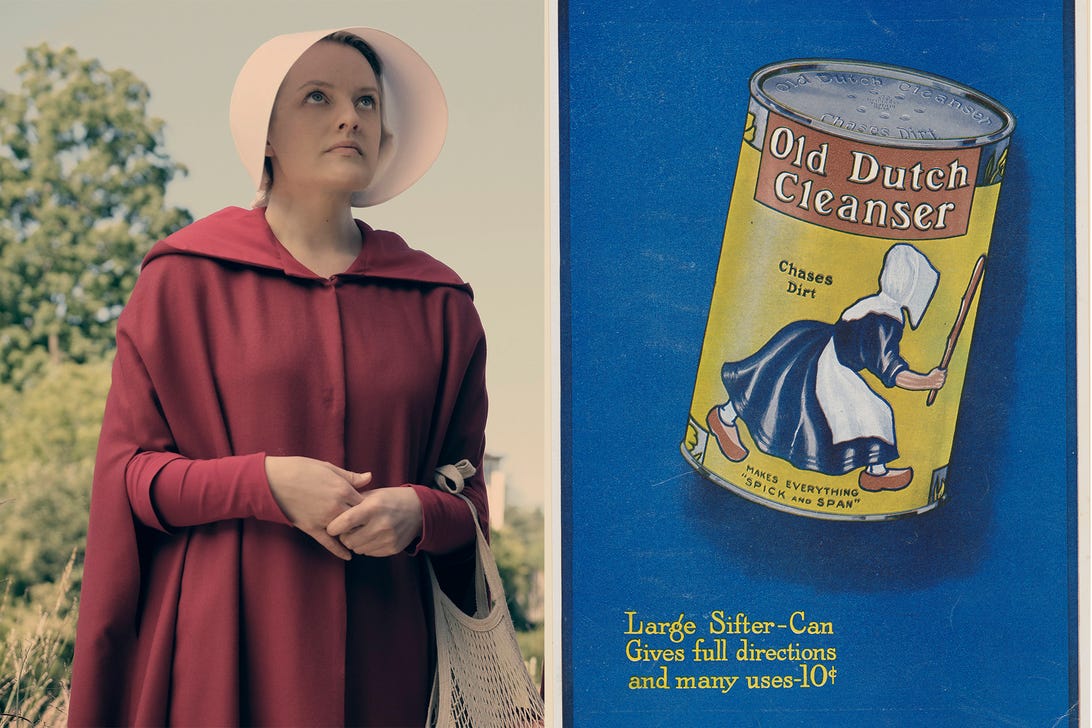
Elisabeth Moss, The Handmaid's Tale (left); advertisement for Old Dutch Cleanser (right)
George Kraychyk / Hulu; Bettmann / GettyThe dress and wings as described by Atwood in the novel were inspired by a design on the Old Dutch Cleanser package from the 1940s; the prolific author has confessed that the imagery frightened her as a child. While Crabtree also looked at the 1990 film -- which stars Natasha Richardson and Faye Dunaway -- for guidance, eventually she found herself discarding everything and starting over. "I'm not trying to recreate the past," she explains.
The story's near-future setting initially presented a few challenges for Crabtree, though. "What we really thought was important, was [showing] modernism in the clothing, because anybody can do a period show and make it feel like oh, this is 1900, this is the '50s. But that's not our show; the story takes place three years in the future," she explains.
"We wanted it to be very timely and of this time, but when you look at the screen you might not know what era you were looking at," she continues. "Maybe you would be looking at any time. Your mind is playing tricks on you and you think 'Is this now, is this the past, is this the future?' Something's been erased and it's like a mind game."
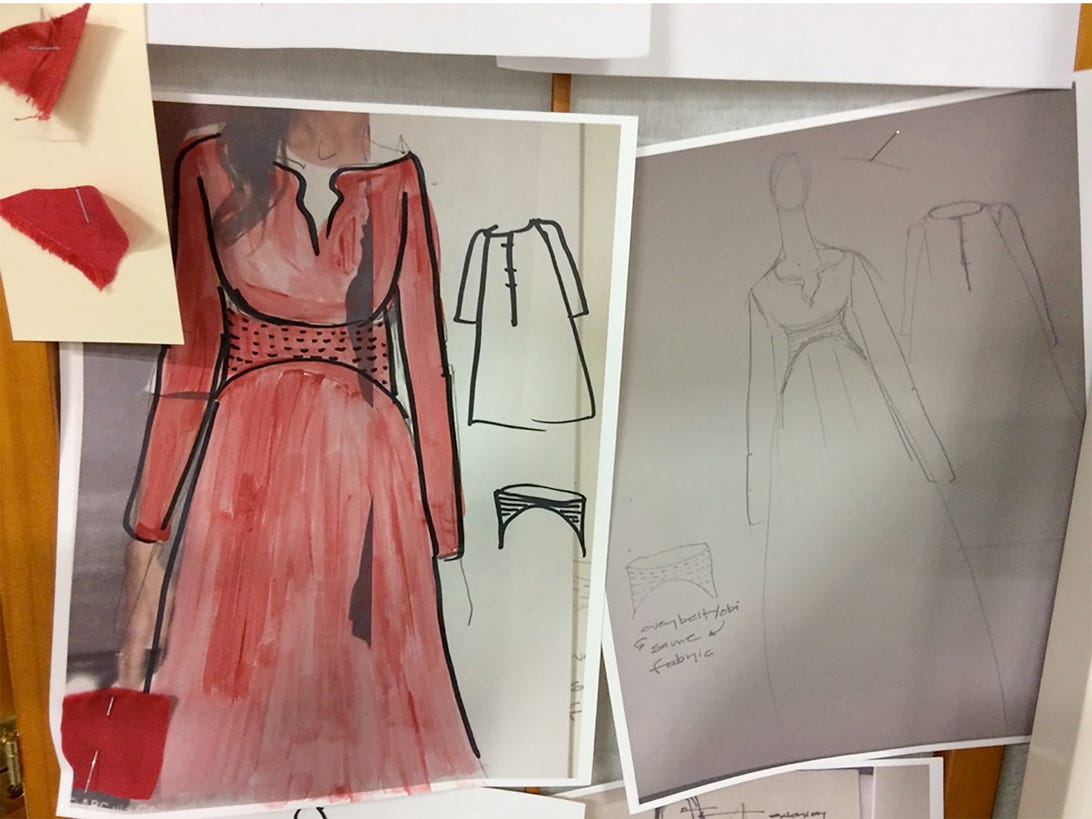
Ane Crabtree's sketch of the handmaid costume
Ane CrabtreeCrabtree took inspiration from many sources, including religious garb ("I come from Kentucky so religion was a great place and an easy place for me to start," she says), the military, pearl divers, Muslim culture, the Amish and even certain looks from ancient Japan.
"Everything [there] is quite clean in the way it's designed, and everything is meant to be almost sort of no time [period], and that's what we really wanted for The Handmaid's Tale," says Crabtree. So she honed in on super-clean, defined canvases of the body, clothing that didn't hinder the shape, but also don't feel like something one would see in an actual period show.
While the world of Gilead is awash in terror and darkness, the handmaids' clothing is rich in vibrant color; Crabtree credits Reed Morano, the Emmy-winning director of the first three episodes of the series, who showed her an image of a red maple leaf against a very "dark, poetic sky." From that photo sprang the stunning blood-red color of the handmaid's cloaks, as well as the striking peacock blue that the commanders' wives wear. "We said 'this is it,' and this is it because it looks like 1950s technicolor, only it's way darker and more dystopic, like our show."
Crabtree also needed the clothes to look like they were born from the minds of the commanders, the men who rule Gilead. As she explains, the clothing had to look like it was created by someone of that mind, someone who was in his mid-40s and very idealistic -- at least about what their mothers, wives, and daughters should look like.
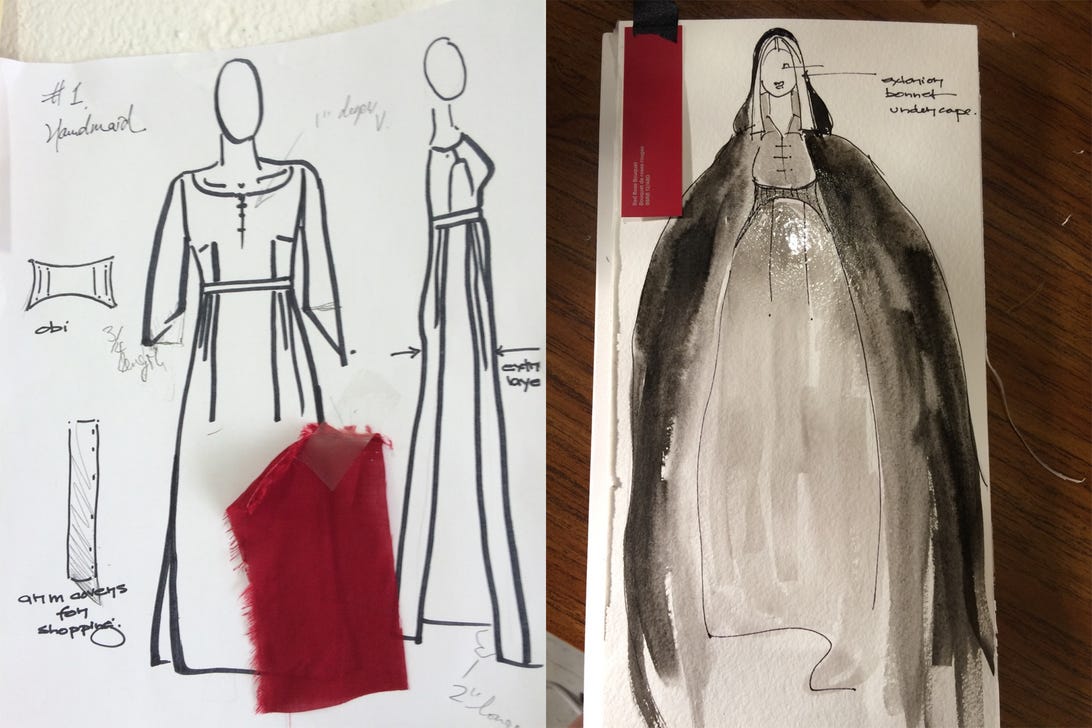
Ane Crabtree's sketches and fabric samples for The Handmaid's Tale
Ane CrabtreeBut there was another aspect of design to consider as well. "There's no money in Gilead," she explains. "Where does the fabric come from? It's woven by either factories who do the rest of the world or the few tailors that are still alive that design for the wives and their husbands. There's an economy to the design that's about reality and what really exists and what their lives are about and the darkness that has descended upon the world." In the end, Crabtree chose rayon as the fabric, because it came in the perfect shade of red and didn't require dyeing.
The color managed to look great on every skin tone, whether the alabaster tone of Moss' skin or the rich melanin of actress Samira Wiley, who plays Offred's best friend Moira. "It was kind of uncanny, and really lucky," Crabtree says, "because the thing we don't have in TV costume design is time to change everything."
As the season progressed and the real world became a mirror to the fictional world in which she worked every day, Crabtree found herself channeling her emotions into her work.
"This is not a show where you can just say, 'Oh, I'm going to just make it pretty' or 'I'm going to just fulfill Margaret Atwood's words' because I think our real lives are parallel to the story and you can't help but throw that in. You can't help it. And I would be a fool if I didn't," she says. "I would really look back with anger at myself if I just did what was on a page. It would be a crime, I think, to myself and to women and to people who are in love with this show and with the book. It's all so big."
But after filming was completed, Crabtree admitted she needed a break. She embarked on a solo train trip in February -- very "zen-like," she says -- to return to the States. "The show was so intense. It was so much a mirror," she says. In fact, it was almost too much; Crabtree found herself almost thinking twice about returning for the show's second season.
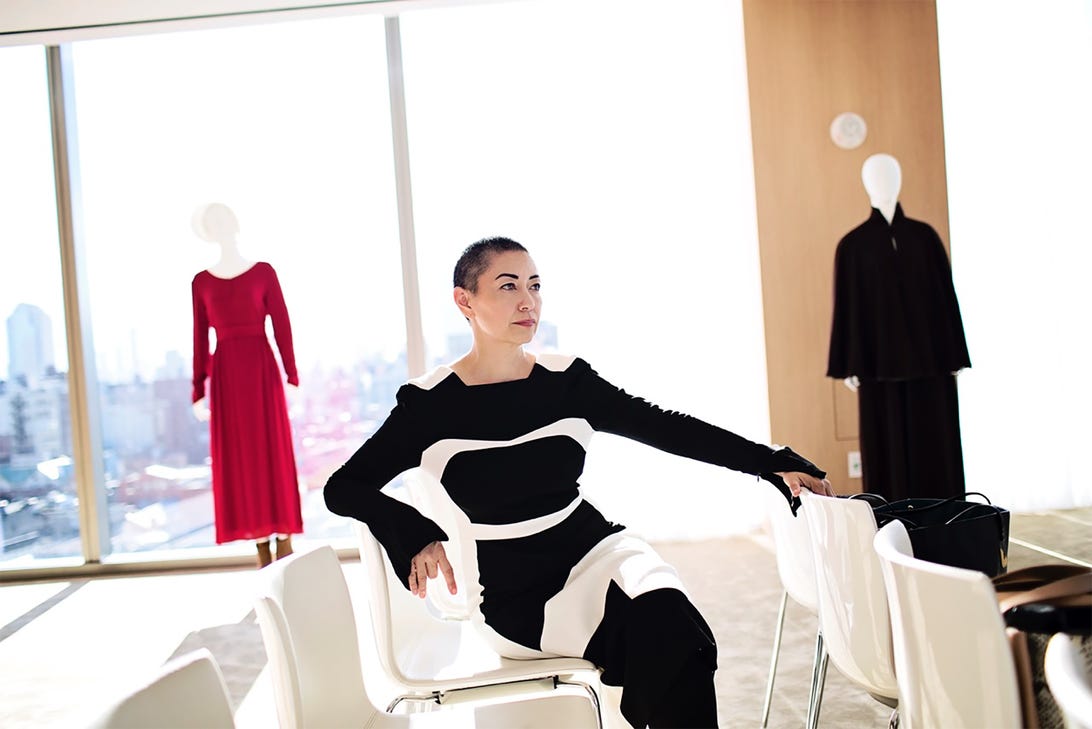
Costume Designer Ane Crabtree
Ane CrabtreeNow Crabtree says she's happy she made the decision to return to the series, which will expand to show the colonies in Season 2. "There's still so much more to say, I'm realizing, from reading the scripts," she says. "[I'm] making great clothing -- thank God for these worlds we have to build because it's never boring. Like, you're never just making a dress or shoes, you're doing full-on worlds of people."
When it came time to design the looks for Season 2, Crabtree found inspiration from another piece of music, a mashup of Dinah Washington's 1950s song "This Bitter Earth" and "On the Nature of Daylight" by Max Richter, a prolific film and television composer. Earlier, she had used the words "bitter earth" to describe "a brand new, giant, epic thing" that requires the series to build a new part of Gilead's society. (Might that be the aforementioned colonies?) "It was so evocative that it stunned me in my tracks," she recalls. "[It has a] very haunting cello that's sort of perfect for The Handmaid's Tale. And as I started putting that on, I literally wept, which just sounds so corny, but it's the way that I know that either a script is good or an idea is good -- not just weeping but getting teary-eyed or moved. And I started sketching. And I immediately created this whole world by putting this song on repeat over and over and over."
I literally wept, which just sounds so corny, but it's the way that I know that either a script is good or an idea is good.
She sent the song to executive producer Bruce Miller and Moss, who was immediately reminded of the first time the two met at that first fitting, back before it all began, before the Emmys, before Trump, before anyone knew what Crabtree's work would come to represent. Crabtree says that they might now use the song in Season 2, and if it's anything like the first season, viewers should expect even more beautiful artwork.
"It's such a different, beautiful, and maybe one-time experience in my whole career," said Crabtree. As the creator of the most iconic costume of the year, perhaps of the entire Trump era, it's no wonder she doesn't let the b--tards get her down.
You can see all of Crabtree's work in the first season of The Handmaid's Tale, which is streaming on Hulu. Season 2 is scheduled to premiere in 2018.
